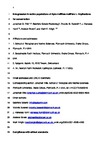Introgression in native populations of Apis mellifera mellifera L: implications for conservation
| dc.contributor.author | Ellis, Jonathan | |
| dc.contributor.author | Soland-Reckeweg, G | |
| dc.contributor.author | Buswell, VG | |
| dc.contributor.author | Huml, JV | |
| dc.contributor.author | Brown, A | |
| dc.contributor.author | Knight, Mairi | |
| dc.date.accessioned | 2018-05-22T10:37:35Z | |
| dc.date.issued | 2018-08 | |
| dc.identifier.issn | 1572-9753 | |
| dc.identifier.issn | 1572-9753 | |
| dc.identifier.uri | http://hdl.handle.net/10026.1/11543 | |
| dc.description.abstract |
Hybridisation and introgression can have negative impacts on regional biodiversity through the potential erosion of locally adapted lineages. The honey bee (Apis mellifera L.) occurs in twenty-seven subspecies across Europe, is an extremely economically important insect, yet threatened by multifarious impacts. Transhumance of the most commercially appealing varieties threatens native honey bee diversity by introgression and subsequent loss of locally adapted traits, or even by complete removal of some subspecies from parts of the range. Here levels of admixture and introgression are examined in UK honey bees suspected to be from hives of the dark European honey bee (Apis mellifera mellifera). Microsatellite DNA and STRUCTURE analyses reveal that the studied populations are generally admixed, and discriminant analysis of principal components shows them to be intermediate between A. m. mellifera and Apis mellifera carnica populations. However, examining mitochondrial haplotype data (COI-COII intergenic spacer region) and nuclear DNA reveal that some hives are relatively pure (from 4 to 15 hives, depending on the Q-value threshold). Genetic diversity is relatively high in comparison with other European populations. Implications for conservation and management are discussed. | |
| dc.format.extent | 377-390 | |
| dc.language | en | |
| dc.language.iso | en | |
| dc.publisher | Springer (part of Springer Nature) | |
| dc.subject | Introgression | |
| dc.subject | Honey bee | |
| dc.subject | Subspecies | |
| dc.subject | Microsatellite | |
| dc.subject | Mitochondrial DNA | |
| dc.subject | Conservation | |
| dc.title | Introgression in native populations of Apis mellifera mellifera L: implications for conservation | |
| dc.type | journal-article | |
| dc.type | Journal Article | |
| plymouth.author-url | https://www.webofscience.com/api/gateway?GWVersion=2&SrcApp=PARTNER_APP&SrcAuth=LinksAMR&KeyUT=WOS:000450733400002&DestLinkType=FullRecord&DestApp=ALL_WOS&UsrCustomerID=11bb513d99f797142bcfeffcc58ea008 | |
| plymouth.issue | 3-4 | |
| plymouth.volume | 22 | |
| plymouth.publication-status | Published | |
| plymouth.journal | Journal of Insect Conservation | |
| dc.identifier.doi | 10.1007/s10841-018-0067-7 | |
| plymouth.organisational-group | /Plymouth | |
| plymouth.organisational-group | /Plymouth/Faculty of Science and Engineering | |
| plymouth.organisational-group | /Plymouth/Faculty of Science and Engineering/School of Biological and Marine Sciences | |
| plymouth.organisational-group | /Plymouth/REF 2021 Researchers by UoA | |
| plymouth.organisational-group | /Plymouth/REF 2021 Researchers by UoA/UoA06 Agriculture, Veterinary and Food Science | |
| plymouth.organisational-group | /Plymouth/REF 2021 Researchers by UoA/UoA07 Earth Systems and Environmental Sciences | |
| plymouth.organisational-group | /Plymouth/Users by role | |
| plymouth.organisational-group | /Plymouth/Users by role/Academics | |
| dcterms.dateAccepted | 2018-05-18 | |
| dc.rights.embargodate | 2019-5-22 | |
| dc.identifier.eissn | 1572-9753 | |
| dc.rights.embargoperiod | No embargo | |
| rioxxterms.versionofrecord | 10.1007/s10841-018-0067-7 | |
| rioxxterms.licenseref.uri | http://www.rioxx.net/licenses/all-rights-reserved | |
| rioxxterms.licenseref.startdate | 2018-08 | |
| rioxxterms.type | Journal Article/Review |


